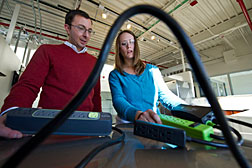- Number 366 |
- July 2, 2012
Sci-Fi no longer, NREL engineers smart homes

NREL engineers Dane Christensen and
Bethany Sparn test advanced power strips
at NREL's Automated Home Energy
Management Laboratory. The lab enables
researchers to study the complex
interactions
of appliances and other
devices in connection to the energy grid.
Credit: Dennis Schroeder
Thanks to TV shows such as The Jetsons and Star Trek, many Americans grew up dreaming that homes of the future would be equipped with fantastic high-tech features, driven by an unlimited supply of energy.
Research engineers at DOE’s National Renewable Energy Laboratory (NREL) have a different vision for the home of the future. The team is working on a "smart" home that will communicate with the electricity grid to know when power is cheap, tell appliances when to turn on or off, and even know when renewable energy resources are available to offset peak demand.
NREL is leveraging two laboratories to make its dream home a reality — the soon-to-be-built Smart Power Laboratory, which is part of the new Energy Systems Integration Facility (ESIF), and the Automated Home Energy Management Laboratory.
NREL's Smart Power Laboratory will focus on two key areas: the development and testing of power electronics systems and controls, and the implementation of newer control approaches for smart energy management devices and systems.
"A part of our research in the Smart Power Laboratory will focus on the integration of distributed energy resources using power electronics; we want to develop a new generation of power electronics systems that will provide advanced functionalities to consumers and utilities, and lead to more efficient integration of renewable energy into the smarter electric grid," NREL Senior Research Engineer Sudipta Chakraborty said. "The present work being done at NREL is on a smaller scale because we are constrained by the size and infrastructure of our current lab. The lab in ESIF will greatly enhance our ability to develop and test bigger power electronics systems."
In addition to the power electronics research, the Smart Power Laboratory's smart grid test bays will be used to develop newer grid-monitoring equipment and to test smart appliances and home automation, energy management, and heating, ventilating, and air conditioning (HVAC) systems. The hardware-in-the-loop system and the capability of real-time control of the megawatt-scale power equipment will enable NREL to simulate integrated system responses such as household loads and generation as seen by the utility, and will ultimately lead to the development of better energy management algorithms.
To help figure out how those pieces must work together inside a home, NREL has built the Automated Home Energy Management (AHEM) Laboratory as part of NREL's advanced residential buildings research.
“We are very cognizant of the fact that every home is part of a larger energy system," NREL Senior Engineer Dane Christensen said. NREL researchers have found that power is viewed differently from either side of the grid.
The homeowner sees that power is always available, at a uniform cost, so there is little motivation to save power during high-demand times and then use power later when it is less constrained. Currently, it doesn't matter to homeowners if they use a clothes dryer while they bake a cake, watch TV, and have all the lights turned on in their house. But, for the grid, that kind of behavior has a huge impact, especially during summer months when air-conditioning is added to the demand mix. Today, utilities have no way to mitigate that power consumption; they simply have to generate and deliver more power.
According to Christensen, the goal is to have communications coming into the home from the utility that include pricing, requests to conserve energy, and rebates to homeowners who can act quickly to reduce power when needed. Conversely, the power company could also send a signal letting homes know that it is OK to go ahead and do laundry while cooking dinner, because there is more power available.
"We're working on building systems for homes that can take the information from the utility, along with input from the homeowner, and manage the home's energy to satisfy both the homeowner and the utility," Christensen added.
Home energy management is a critical area for the DOE Building America program to reach its long-term goals of at least 50 percent energy savings for new construction and 40 percent savings over the minimum code for building retrofits.
Building America is the flagship program for residential research within the Building Technologies Program at DOE. The goal is to make energy efficiency cost effective for residential buildings; NREL is the technology lead and manager for the program.
Learn more about the Energy Systems Integration Facility and NREL's Residential Buildings Research.
[Heather Lammers, 303.275.4084,
heather.lammers@nrel.gov]
